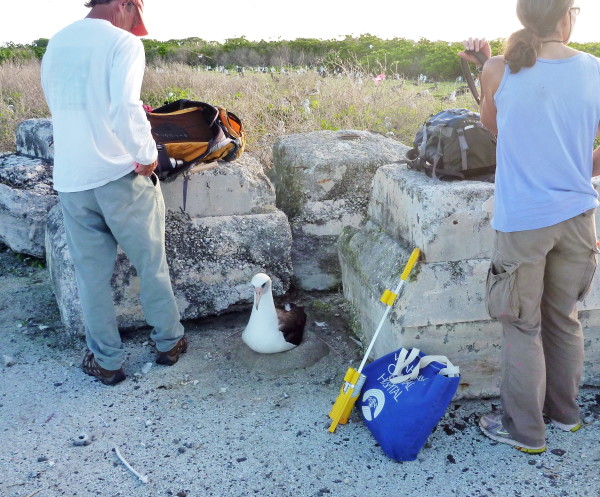Published in the Ocean Watch column, Honolulu Star-Advertiser © Susan Scott
April 4, 2016
After reading about my experiences at Midway, home of the largest albatross colony in the world, Mililani resident Jim May emailed me excerpts of letters his great-grandfather Edward May wrote. Edward was the paymaster aboard the USS Lackawanna when its captain claimed possession of Midway for the U.S. in 1867.
After raising the American flag, the crew explored Midway’s two islands. “Both are fairly covered with birds that don’t care any more for a man than for one of their own kind,” Edward wrote. “They won’t move off their nests unless you push them over.”
 Biologists working at Midway Atoll stand next to a fearless Laysan albatross.
Biologists working at Midway Atoll stand next to a fearless Laysan albatross.
Because albatrosses evolved without land predators, they have no fear of people.
©2016 Susan Scott
Edward killed 16 albatrosses for food, writing that he felt “mean for pegging away (hitting) at them and abusing their confidence.”
Jim thought I might be appalled by the description of the men bludgeoning the docile bird. I am not. Sailors had to eat.
What is appalling is the subsequent slaughter of millions of albatrosses for feathers on women’s hats. And even more appalling is the recent butchery of Kaena Point albatrosses. The fact that some 19th-century sailors felt bad about killing albatrosses for food says a lot about the depravity of the Kaena Point vandals.
There are, however, bright sides in Hawaii’s albatross history. In 1903 President Theodore Roosevelt stopped the mass killing of seabirds in Hawaii’s northwest chain, and today the enormous area is protected as the Papahanaumokuakea Marine National Monument.
In the early 1980s at Oahu’s Kaena Point, I saw men in pickup trucks shooting albatrosses. Now Kaena Point is a jewel in the state’s Natural Area Reserve system, and the public was outraged over the December bird killings there. The case is pending.
Innovation is also at work today with multiple groups working together to create a new albatross colony at James Campbell National Wildlife Refuge in Kahuku. The refuge is, understandably, closed to the public.
It’s easy to get discouraged about wildlife conservation in Hawaii, but consider how far we’ve come. John Berger, the range complex sustainment coordinator at Barking Sands, said it perfectly in an email he sent about last week’s column. He appreciated the article for “recognizing not what we did, but what we are doing, and what we can expect in the future.” Thanks to all for writing.